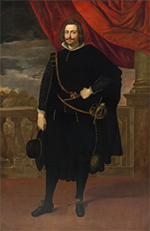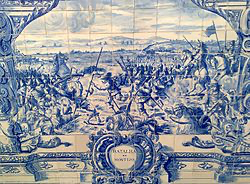King John IV of Portugal
John IV was King of Portugal for 16 years in the 17th Century, restoring native control to his country after 60 years of Spanish rule. Spain's Philip II had taken control of Portugal after a succession dispute in 1580, and he ruled as King Philip I of Portugal for 17 years as the sovereign of the Iberian Union. Succeeding him in 1598 was his son, Philip III of Spain and Philip II of Portugal. After 23 years, the crown passed to yet another monarch of the same name, Philip IV of Spain and Philip III of Portugal. It was that king against whom the people of Portugal rose up in revolt, in 1640, while the rest of Europe was ablaze with the Thirty Years War and while the Spanish throne was also occupied with putting down a revolt in Catalonia. The first two kings named Philip had not imposed harsh conditions on the Portuguese people. That was not the case with Philip III (Philip IV of Spain), who, as the Thirty Years War progressed, raised taxes and curtailed the rights and privileges of the nobility. Ultimately, it was a consortium of nobles known as the Forty Conspirators who rose up and led a rebellion, assassinating the Secretary of State, Miguel de Vasconcelos, and imprisoning the king's designate, his cousin, Margaret of Savoy. The rebels then, on Dec. 1, 1640, proclaimed John, Duke of Braganza, as their new king. John, the wealthiest nobel in the country, had fully participated in the rebellion. 
John had been born on March 19, 1604, at Vila Viçosa. His father was Teodósio, the Duke of Braganza, and his mother was Ana de Velasco y Girçn. John's grandmother was Catherine, Duchess of Braganza, and it was through her lineage that he claimed legitimacy of accession to the throne, for she was the granddaughter of a previous Portuguese monarch, Manuel I. (It was through that monarch that Philip II had claimed his right of accession: He was Manuel's grandson.) Among the masterminds of the plot against the foreign monarch was Antão Vaz de Almada, the Count of Avranches; it was he captured Margaret of Savoy. John IV rewarded him by naming him an ambassador to England. Members of the clergy and the military took part in the rebellion as well. Other members of the Forty Conspirators included these:
Although the Portuguese people recognized John IV as their sovereign, the Spanish king had other ideas and refused to give up easily, despite the ongoing war in Europe, which ended for all but two powers in 1648 and carried on with France for another 11 years after that. The government of John IV forged alliances with France and Sweden in 1641 but contributed little to the prosecution of the Thirty Years War. Portuguese forces were more active overseas, struggling against Dutch forces in Malacca, Ceylon, northern Brazil, and what is now Angola. 
The Portuguese Restoration War consumed manpower and money on both sides for more than two decades. The new monarch wasted no time preparing for a military response from Spain. John set up a Council of War and set up a defense system for border fortresses and ports. Philip sent armies across the border a number of times, without success. The struggle was more a long-running dispute punctuated by a large number of raids, skirmishes, and standoffs than an all-out war. Portugal's first major success came in 1644, at the Battle of Montijo, when troops under General Matias de Albuquerque seized victory from the ashes of defeat, drove the Spanish army from the field, and, having seized a town in Spain, gained recognition elsewhere in Europe. The revolt in Catalonia dragged on as well. Spain ended it in 1652, after 12 years of struggle. However, Spain was still fighting in the north, against France. The Portuguese war was still raging when King John IV died, on Nov. 6, 1656. Succeeding him was his son, Afonso VI. John had married Luisa de Guzmán in 1633, and they had had seven children, five of whom survived into adulthood: Teodósio (1634), Joana (1635), Catherine (1638), Afonso (1643), and Peter (1648). Another legacy of John IV was in the arts. He was a patron of musicians and writers and was himself a both a composer and writer of some repute. He compiled a great number of items in what became one of the largest libraries in the world. The short-lived collection disappeared in the aftermath of a large earthquake in 1755.
|
|
Social Studies for Kids
copyright 2002–2026
David White




